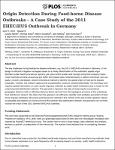Origin Detection During Food-borne Disease Outbreaks – A Case Study of the 2011 EHEC/HUS Outbreak in Germany
Manitz, Juliane
Kneib, Thomas
Schlather, Martin
Helbing, Dirk
Brockmann, Dirk
The key challenge during food-borne disease outbreaks, e.g. the 2011 EHEC/HUS outbreak in Germany, is the design of efficient mitigation strategies based on a timely identification of the outbreak’s spatial origin. Standard public health procedures typically use case-control studies and tracings along food shipping chains. These methods are time-consuming and suffer from biased data collected slowly in patient interviews. Here we apply a recently developed, network-theoretical method to identify the spatial origin of food-borne disease outbreaks. Thereby, the network captures the transportation routes of contaminated foods. The technique only requires spatial information on case reports regularly collected by public health institutions and a model for the underlying food distribution network. The approach is based on the idea of replacing the conventional geographic distance with an effective distance that is derived from the topological structure of the underlying food distribution network. We show that this approach can efficiently identify most probable epicenters of food-borne disease outbreaks. We assess and discuss the method in the context of the 2011 EHEC epidemic. Based on plausible assumptions on the structure of the national food distribution network, the approach can correctly localize the origin of the 2011 German EHEC/HUS outbreak.
No license information

